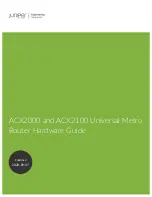
306
C
HAPTER
28: Q
O
S C
ONFIGURATION
In the following section, weighted round robin (WRR), and HQ-WRR (High
Queue-WRR) queues are introduced.
WRR queuing
Figure 96
Diagram for WRR queuing
WRR queue-scheduling algorithm schedules all the queues in turn and every
queue can be assured of a certain service time. Assume there are eight priority
queues on a port. WRR configures a weight value for each queue, which is w7,
w6, w5, w4, w3, w2, w1, and w0. The weight value indicates the proportion of
obtaining resources. On a 100 M port, configure the weight value of WRR
queue-scheduling algorithm to 50, 50, 30, 30, 10, 10, 10, and 10 (corresponding
to w7, w6, w5, w4, w3, w2, w1, and w0 in order). In this way, the queue with the
lowest priority can get 5 Mbps bandwidth at least. Another advantage of WRR
queue is that: though the queues are scheduled in order, the service time for each
queue is not fixed; that is to say, if a queue is empty, the next queue will be
scheduled. In this way, the bandwidth resources are made full use.
HQ-WRR queuing
HQ-WRR is an improvement over WRR. With queue 3 allocated with the highest
priority, the switch will ensure that this queue get served first and will perform
round-robin scheduling to the other three queues when the traffic has exceeded
the bandwidth capacity of a port.
Burst
The Burst function can provide better packet cache function and traffic forwarding
performance. It is suitable for networks where
■
Large amount of broadcast/multicast packets and large burst traffic exist.
■
Packets of high-rate links are forwarded to low-rate links or packets of multiple
links with the equal rates are forwarded to a single link that is of the same rate
as that of the incoming links.
Packets to be sent
through this port
Packet
classification
Queue
scheduling
Queue 2 weight
2
Queue N
-
1 weight N
-
1
Queue N weight N
Sent packets
Sending queue
Interface
ಹಹ
Queue
1
Queue
2 Weight
2
Queue N
-
1
Weight N
-
1
Queue N
Weight N
Weight
1
Summary of Contents for Switch 4210 9-Port
Page 22: ...20 CHAPTER 1 CLI CONFIGURATION ...
Page 74: ...72 CHAPTER 3 CONFIGURATION FILE MANAGEMENT ...
Page 84: ...82 CHAPTER 5 VLAN CONFIGURATION ...
Page 96: ...94 CHAPTER 8 IP PERFORMANCE CONFIGURATION ...
Page 108: ...106 CHAPTER 9 PORT BASIC CONFIGURATION ...
Page 122: ...120 CHAPTER 11 PORT ISOLATION CONFIGURATION ...
Page 140: ...138 CHAPTER 13 MAC ADDRESS TABLE MANAGEMENT ...
Page 234: ...232 CHAPTER 17 802 1X CONFIGURATION ...
Page 246: ...244 CHAPTER 20 AAA OVERVIEW ...
Page 270: ...268 CHAPTER 21 AAA CONFIGURATION ...
Page 292: ...290 CHAPTER 26 DHCP BOOTP CLIENT CONFIGURATION ...
Page 318: ...316 CHAPTER 29 MIRRORING CONFIGURATION ...
Page 340: ...338 CHAPTER 30 CLUSTER ...
Page 362: ...360 CHAPTER 33 SNMP CONFIGURATION ...
Page 368: ...366 CHAPTER 34 RMON CONFIGURATION ...
Page 450: ...448 CHAPTER 39 TFTP CONFIGURATION ...
Page 451: ......
Page 452: ...450 CHAPTER 39 TFTP CONFIGURATION ...
Page 470: ...468 CHAPTER 40 INFORMATION CENTER ...
Page 496: ...494 CHAPTER 44 DEVICE MANAGEMENT ...
















































